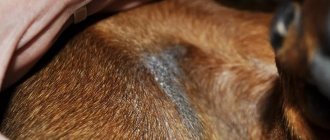Causes
Alas, the most common causes of black excrement are diseases. It is important to know that two types of blood can be present in stool. Bright red and dark black. The latter is the most dangerous, as it comes out of the small intestine or stomach.
What are the main causes of black stool in dogs?
- Worms. If you forget that periodically they need to be expelled from the dog’s body, then these comrades will only be happy. They settle safely in the small intestine. And they begin to eat its mucous membrane. Naturally, they eat away until they bleed. This very blood leaves the dog’s body, giving its excrement a black color;
- Enteritis. This is much more serious than worms. Let's start with the fact that there are two types of enteritis. Hemorrhagic gastroenteritis and parvovirus enteritis. Small breed dogs are prone to the former. Inflammation occurs in the stomach and intestines, and black feces in dogs are its consequence. The causes of this disease are not yet known. Either it’s stress that has this effect on the body, or a previous infection, or problems with blood circulation. The second type of enteritis is very dangerous for puppies and young dogs. If measures are not taken in time, the animal dies within 3 days;
- Stomach ulcer. Dogs, like people, have peptic ulcers. When the ulcer opens, it begins to bleed. As a result, the owner can see black feces in the pet;
- Foreign object in the gastrointestinal tract. It happens. The dog swallows something sharp, and this is the result. By the way, for this reason it is forbidden to give chicken tubular bones to your pets. And if the owner plays “stick” with the dog, he should be especially careful so that the pet does not swallow a sharp piece of the stick.
Weakness, dark feces, vomiting in an angry dog
Hello! The dog is 9 years old, weight 30-35 kg. After eating, 1-2 hours later he vomits food and mucus, the stool is dark, the nose is cold, the dog is weak. The dog is angry, sitting on a chain. It’s very difficult to invite a doctor, the dog won’t let you in, taking him to the doctor is the same. What to do? Please tell me.
Answer
If a dog vomits once, the phenomenon may not cause concern; it serves as a protective reaction of the body to the entry of a foreign body or toxins into the stomach. Repeated vomiting indicates that the animal has serious health problems.
Causes of symptoms
A common cause of vomiting is the entry of a foreign body into the stomach: bone fragments, sticks, stones, small toys, pieces of rags, pillows or baby diapers. The pet could have swallowed the foreign body as a result of hunger, while playing, or out of curiosity. This happens when a dog is left unattended.
The occurrence of vomiting is associated with a change in the nature of feeding - the introduction of new products, a change in ready-made factory feed. Vomiting often occurs when the food content is high in fat.
Animals with hypersensitive stomachs may be intolerant to a number of foods - corn, selected grains, milk and dairy products are contraindicated.
Darkening of the stool is associated with bleeding in the stomach or esophagus. The symptom may indicate the presence of gastritis in the pet, a foreign body in the stomach that injures the walls.
Digested blood, excreted in feces, turns the feces dark. The overall clinical picture causes weakness and general malaise.
A common cause of vomiting and darkening of stool is intestinal obstruction in a dog.
Urgent help for a pet
If the dog does not allow itself to be examined, it is possible to provide the dog with first aid by adjusting its diet.
- If the animal repeatedly vomits, it needs a “starvation diet.” Do not feed your pet for 24 hours.
- Leave plenty of fresh water during fasting. If vomiting recurs after drinking heavily, it is necessary to limit fluids by giving the animal a few tablespoons of water every 30 minutes. This will help you stay hydrated and prevent vomiting from happening again.
- After 12 hours, give as much water as you want.
- If a day has passed and the animal does not vomit again, feed it semi-liquid rice porridge with water. Give 2-3 tablespoons every 1.5-2 hours.
- If your pet does not resume vomiting, add boiled skinless chicken, chopped or ground, to the rice.
- The next days the dog eats semi-liquid food, easy to digest and low-fat.
A gentle diet is sometimes prescribed for long periods, depending on the condition of the pet.
How to restrain a dog for inspection
Try restraining your pet for a doctor's examination at home. The owner or caregiver must restrain the pet. The process is controlled by a veterinarian or an experienced dog handler. You are supposed to talk to the dog quietly and affectionately, stroke behind the ears and along the withers.
If the dog shows aggression or a painful manipulation is to be performed, the owner is supposed to grab the dog’s skin in a fold in the nape area and hold tightly, lightly press down, forcing the animal to sit down.
Having achieved this, the owner places his second hand under the pet’s lower jaw and holds it in the chin area. The second person (the veterinarian) places a loop with a knot of gauze bandage folded in half over the animal’s upper jaw. The location of the node is at the bottom.
The ends of the loop should be firmly fixed with a double knot on the back of the dog’s head.
To prevent the knot from slipping, it is possible to insert a small wooden stick between the jaws, behind the fangs. The ends of the bandage are screwed onto the stick on both sides. Then the bandage is fixed on the back of the head in the standard way. It is possible to secure the dog's mouth with a muzzle.
Approved anti-vomiting medications
As a symptomatic treatment, give the animal anti-vomiting medications. However, such treatment will not affect the causes of the disease and is not considered complete.
Anti-vomiting medications are divided into two categories - the first improve and normalize peristalsis. They affect intestinal motility and promote the normal passage of food through the digestive canal. Then the food does not come back, vomiting does not occur. The drugs are suitable when the animal suffers from nausea. The most common drug allowed for dogs is cerucal, or metoclopramide.
The second group of drugs has a depressing effect on the vomiting centers of the brain. The mechanism of action is due to the neutralization of vomiting at the level of the central nervous system. Drugs include Ondansetron or Serenia.
Source: https://DogCentr.ru/voprosyotvety/slabost-tyomnyj-kal-rvota-u-zloj-sobaki.html
Symptoms of certain diseases
We found out why a dog might have black feces. Now you have to deal with additional symptoms of some diseases.
Let's take worms. A dog infected with them is lethargic. Her eyes are cloudy, the pet refuses to walk and play. But the appetite is just crazy. The dog eats everything he sees. She is constantly hungry. What should the owner do? Buy deworming tablets and give them to your dog.
Viral enteritis. This is an infectious disease, and you can protect your puppy from it by getting vaccinated. Just remember: vaccination is not a panacea for all ills. It is also important to comply with the conditions of content. For example, the dog is fed correctly, and has a separate place for rest. It started snowing, and the owners were walking with the puppy at that time. And they walked for a long time. The baby is wet and his immune system is weakened. And hello, enteritis.
How does it manifest itself, besides the fact that the dog has black stool? The animal vomits, the feces are speckled with blood clots. The dog is lethargic and lies all the time. She may have seizures. Refuses to eat and drink.
What measures should the owner take? We remember that infection very quickly destroys the puppy. Therefore, you need to urgently call a veterinarian. Treatment is usually carried out at home. This is the placement of IVs. The sooner treatment begins, the higher the pet's chances of survival.
In case of gastric bleeding, the owner’s best decision would be to call a veterinarian.
If a foreign object gets into your pet’s gastrointestinal tract, know that the condition worsens very quickly. Don't hesitate to visit a veterinarian.
For what reasons can dogs' stool become dark or black in color?
Russian dog walkers do not yet have the habit of carrying bags and collecting dog excrement while walking. But attentive owners monitor the condition of the stool. When they see black feces on a dog, they sound the alarm.
Normal dog poop
The dog has bowel movements 3-4 times a day. If it's less, it's okay. The waste products of a healthy dog range from light to dark brown.
The dog relieves itself
The consistency is moderately dense, without breaks or inclusions. After defecation, feces for some time retain the shape of a smooth “sausage” with a damp sheen and a not strong odor. In circumference, the discharge product is equal to the size of a dog's anus.
It is normal for small fragments of the “sausage” to fall out in the form of circles with the same healthy shine. The owner understands that there is not enough fiber in the diet.
But there are deviations from the norm for dog stool:
- The discharge is formed correctly, but at the end of the bowel movement a liquid mush is poured out - dysbacteriosis or infection is possible.
- There is mucus and blood in the stool - worms or there is a lot of raw meat on the menu.
- There is undigested food in the feces with a sour smell, defecation more than three times a day - it is necessary to establish a balanced diet.
- White coating on hard feces - bones are removed from the diet.
- A dog with black stool is a sign of bleeding internal ulcers. We are talking about damage to the upper gastrointestinal tract or small intestine. The reason may be eating rat poison that the dog found somewhere.
Important! The most life-threatening feces for a pet are liquid feces with bloody foam. Immediately call an ambulance to save the animal.
Sick animal
The main causes of black feces in dogs
Dark stool indicates that the dog is bleeding internally. If the blood comes from the anus or colon, it is scarlet or bright red. But when it is treated with digestive enzymes, it turns black. This means that the cause of bleeding is located deep in the internal organs - the stomach, small intestine.
A cat has a black nose: causes of discharge and treatment options
Serious causes of black feces in dogs:
- Worms. They live on the intestinal mucosa, first destroy it, then get to the animal’s blood. Some of it enters the intestinal cavity and is then excreted.
- Infection. More often it is a parovirus. Blood comes out in clots, feces are unevenly colored.
- Stomach ulcer. A serious illness when black poop is observed in a dog.
- Hemorrhagic gastroenteritis. It occurs as a complication after infections, inflammation of the gastrointestinal tract, due to circulatory disorders.
Important! It is difficult to determine the nature of dark excrement on your own, so contact a veterinarian.
At the veterinarian's appointment
Physiological reasons
Black Spitz: Pomeranian black and tan or black and white dog
There is no need to panic right away. If it is a one-time occurrence, the explanation may be simple. It is possible that the dog was prescribed iron-based medications or vitamin supplements with ferrum during this period. Then the dog’s dark feces will be natural.
Also, the color of stool changes when activated charcoal is given to a dog that is poisoned. The same thing happens if the dog is fed raw meat or blood meal with black licorice is added to the food.
The owners in these cases continue to monitor their four-legged friend. Contact the clinic if other signs of ill health appear: lethargy, fever, refusal to eat.
What did you eat?
Jack Russell Terrier: black, white, brown, tri-color and other colors
During walks, four-legged animals sniff out and pick up inedible things from the floor: plastic objects, stones, sticks.
Small puppies are often guilty of this: York terriers, dachshunds, Rottweilers. A sharp foreign object can cut the thin wall of the stomach - hence the blood in the digestive tract and dark stool in the dog.
The same condition develops after food poisoning.
You need to watch what your dog puts in his mouth while walking.
The color of the feces depends on the food that the owners offer the animal. Raw liver, other offal, and uncooked meat will give the feces a dark or black color.
Important! There is no reason to worry if the puppy is cheerful, active, with neat fur and clear eyes.
Signs of pathology
A sensitive attitude towards your pet helps to avoid many canine ailments. If, along with dark stools, the dog has changed its behavior, has become apathetic, its eyes become sour, suffers from flatulence, and vomiting appears, contact a specialist.
The following pathologies are accompanied by black feces.
Oncological diseases
Stomach cancer, which is accompanied by black liquid feces in dogs, is not a common occurrence. This is the karma of large dogs: collies, terriers, shepherds, bull terriers. Older individuals, more often males, become ill.
Important! Veterinarians do not name the exact cause of the disease. They think it's stress, unhealthy diet, toxins, radiation.
The onset of the disease occurs without specific symptoms. The animal moves less and eats poorly. Owners are alarmed by weight loss, vomiting, belching, and gases with the smell of a rotten egg.
A malignant tumor is diagnosed in the clinic. Treatment often leads to positive results.
Oncological diseases need to be detected early
Manifestation of diarrhea
Indigestion is caused by spoiled foods, helminths, food allergies, gastritis, infections and poisoning, and overeating. The stool becomes liquid and dark in color.
Diarrhea for several hours or one day is normal. The dog is fed less and given a lot of water. But if the condition drags on for several days, the patient is taken to the doctor. The specialist identifies the cause and prescribes treatment. Advice from fellow dog breeders can lead to serious consequences.
Important! Diarrhea is dangerous due to dehydration and metabolic disorders.
Hemorrhoidal bleeding
The dog has prolonged constipation, hard feces with blood, itching and redness around the anus. She tries to reduce discomfort by crawling on the floor on her butt and often licking the anus.
All signs indicate that the pet has hemorrhoids - the hemorrhoidal veins have dilated, and blood has stagnated in them. This ends with the protrusion of the nodes from the anus, or they are localized in the rectum.
Hemorrhoids in a dog
They treat with enemas, suppositories, soft nutrition. The disease is usually easy to treat.
Infectious, toxic gastroenteritis
The causes of the disease are viruses, intoxication, bacteria. The disease is accompanied by striking symptoms: black loose stools, weakness, intestinal colic. The body temperature rises, the pet begins to drool, and the heartbeat quickens. Paws, nose and ears become cold, vomiting bile and blood.
Treatment begins with fasting. The dog is given only a drink, then boiled rice in small portions. The veterinarian prescribes strengthening agents and antibiotics.
When a visit to the vet should not be postponed
If a puppy or adult has dark stool for several days and is accompanied by alarming symptoms, the animal is sent for examination.
Healthy animal
What's alarming:
- admixtures of black blood in the stool (if it is scarlet, the dog has internal bleeding);
- pain in the abdomen, the pet does not allow you to touch it;
- temperature;
- vomit.
The dog's behavior changes: it loses playfulness, refuses to eat, worries, and whines. In many cases, the pet can be restored to its feet, but a competent person must diagnose the disease and treat it.
A dog’s black stool, noticed by the owner, is a reason to take a closer look at the dog. It can be caused by harmless reasons: eating raw meat and liver, a foreign object in the stomach. But if along with it the animal’s general well-being has worsened (vomiting, fever, trembling, refusal to eat), seek qualified help from a specialist.
Source: https://gafki.ru/sobaki/cherniy-kal.html
Preventive measures
How to treat black feces in a dog? It all depends on the type of disease. If it is serious, then antibiotics and IVs are used. In this case, only a veterinarian can prescribe treatment.
Frightening poop is easier to prevent than to treat later. How to do it? Listen to our recommendations:
- Do not feed your pet raw offal frequently. You can give it occasionally. It’s better to boil them, it will be calmer;
- Give anthelmintics on time. Once a quarter is best. The specialist who is seeing the dog will tell you which tablets are suitable for your pet;
- vaccinate your pet. Other owners believe that only a rabies vaccination is necessary. This point can be disputed. The infectious diseases described above have not yet been canceled;
- If you notice that your dog is behaving strangely, do not put off visiting a doctor. Just yesterday your pet was active, but today he’s lying down and breathing heavily? You should not hesitate to seek medical help in this case;
- When playing with your pet, be careful. Make sure he doesn't swallow the sharp edge of the stick;
- Don't give your dog long bones. Never and under any circumstances. If you want to pamper your dog, give him a beef sugar bone with rounded ends.
How to treat?
Warning about preventive measures is a good thing. But how to treat black feces in a dog?
It all starts with analysis. To make a diagnosis, stool is taken for a general analysis, the presence of infectious diseases and protozoa.
That's not all. The dog is prescribed a gastroscopy. The procedure is not the most pleasant, to be honest.
Ultrasound of the gastrointestinal tract. It certainly helps to identify both foreign objects in the declared organs and the presence of an open ulcer.
Clinical examination of the dog. You can't go anywhere without this.
Only after all the manipulations will the pet be prescribed treatment. And the veterinarian's instructions must be strictly followed.
If a dog has stomach problems, he will be prescribed special food. Accordingly, the owner must provide the animal with food.
Possible pathologies
If your dog has black stool, you need to rule out the following reasons:
- Foreign body. Often found in puppies who love to chew and swallow everything that gets into their mouth.
mouth These can be fragments of bones, chips from sticks, glass and even pieces of iron. All this can lead to injury to the stomach wall, which will lead to the accumulation of blood, which is digested and turns the stool black. If radiography and ultrasound of the stomach do not help to establish or exclude the presence of a foreign body, then a diagnostic laparotomy is performed, during which an incision is made in the abdominal wall. Patients with suspected foreign body entry into the intestine should be immediately taken to the hospital for surgery. Otherwise, you may lose your pet due to blood loss. You can expect the foreign body to leave the intestines naturally only after consultation with a veterinarian, who will assess the animal’s condition and determine the need for surgical intervention. - Helminthiasis. The presence of parasites in a dog can cause black feces, but upon examination it will be revealed that this is not staining, but the presence of small worms. This phenomenon is often observed in animals that lived in nurseries or on the street. With helminthiasis, vomiting and diarrhea are also observed. Appetite and thirst may increase. Against the background of helminthic infestation, gastroenteritis may appear. Treatment of the pet with Febtal or Kanikquantel is considered an effective solution to the problem. The dosage and duration of the course are calculated based on the age and weight of the dog. Particular attention is paid to disinfection during treatment. To avoid relapses, all animals living in
home, are treated against parasites, objects with which the infected animal has been in contact are thoroughly washed with bleach. - Parvovirus. An infectious disease that is dangerous because many animals die from it in the first 2-3 days, and survivors can have serious complications of the heart and kidneys. The virus is found in feces and can survive in the environment for up to six months. It always manifests itself acutely - vomiting, black feces, dehydration and stomach pain. Visible symptoms include severe shortness of breath at rest and trembling of the limbs. The only chance to avoid parvovirus enteritis is timely vaccination in the first months of a puppy’s life and subsequent revaccination throughout life.
- Gastroenteritis. Inflammatory disease of the gastric and intestinal mucosa. It can be primary (after poisoning with spoiled foods, low-quality food) or secondary (as a reaction to helminths, fleas, parvovirus or carnivorous plague). Manifested by severe vomiting, black diarrhea, refusal to eat, and apathy. Diagnosis is carried out based on the general condition of the pet and complaints
owner. An abdominal ultrasound and x-ray may be needed. Particular attention is paid to stool analysis, which can confirm or exclude the presence of helminths or a viral infection. Only after determining the root cause of gastroenteritis can you count on successful treatment. In any case, a strict diet, deworming and removal of toxins from the body are indicated (if the cause is poisoning after eating something while walking). - Tumors. Occurs mainly in older dogs. They can be benign (polyps) or malignant (adenocarcinoma). If there is a formation in the intestines, there is vomiting, diarrhea and general weakness. Black stool may indicate ulceration of the tumor. With polyps, there may be diarrhea with blood. To confirm the diagnosis it is necessary
perform a colonoscopy and biopsy of the formation. If a malignant course is confirmed, part of the stomach or intestine is removed (depending on location). The removed materials are sent for histology. For aggressive forms of cancer, chemotherapy is indicated. If the malignancy of the tumor is confirmed, the prognosis is cautious, since the chance of relapse even after complete removal of the tumor is very high.
Finally, I would like to remind you that a dog may develop black stool after eating certain types of meat or chicken liver. If there are no accompanying symptoms, then this can be considered a normal variant. Black staining of stool after surgery or long-term use of antibiotics can also be considered a conditionally normal condition. But here you can’t do without consulting a veterinarian.
Russian dog walkers do not yet have the habit of carrying bags and collecting dog excrement while walking. But attentive owners monitor the condition of the stool. When they see black feces on a dog, they sound the alarm.
Does it happen that treatment doesn’t help?
Alas, veterinarians are not gods. The same enteritis cannot always be cured. The disease develops too quickly, and in its later stages nothing will help.
Therefore, as soon as the owner notices black feces in a dog or puppy, he should immediately contact a veterinarian. Especially when black feces are an “addition” to the signs described above.











